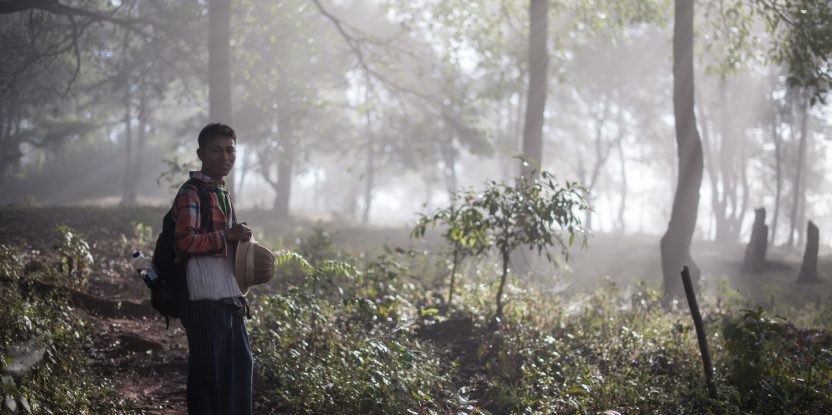
As decision makers in Myanmar move to draft a REDD+ country strategy, a workshop was held in the capital, Naypyidaw, to gather insights from 13 developing countries already implementing the scheme.
The purpose of the workshop was to provide a platform for experts, government representatives and development practitioners, among others, to share insights on the opportunities and obstacles encountered in implementing REDD+ worldwide. Hosted by the Center for International Forestry Research (CIFOR) and partners, the event included an in-depth presentation of CIFOR’s Global Comparative Study on REDD+ (GCS REDD+), which focuses on benefit-sharing mechanisms and the ‘three Es’ of efficiency, effectiveness and equity.
The ongoing GCS REDD+ study has been conducted since 2009, and examines various topics such as policy design, policy options for benefit-sharing mechanisms, and how different technologies can be used to measure forest quality and quantity. CIFOR researchers discussed the findings so far with policy makers and REDD+ practitioners in Myanmar in a bid to find applicable insights.
“We also hope to understand and learn more about government priorities so that in the next five years we can align our research to inform policy makers with solid science,” said Pham Thu Thuy, the study leader on policy.
“We will work together with national research institutes and the Department of Forestry to help [Myanmar] with knowledge and tools to develop their country strategy for REDD+ and analyze jointly the current drivers of deforestation, barriers, technical gaps and successes. The goal in a year is to have a comprehensive analysis of institutional drivers of deforestation,” she added.
DEVELOPING REDD+ IN MYANMAR
Forest cover in Myanmar over the last 30 years has dropped from 60% to less than 40%. The main drivers have been development, illegal logging, and expanding economic infrastructure, according to local speakers at the workshop.
Nyein Chan is an assistant lecturer at the University of Forestry in Yezin, near Naypyidaw, with a focus on forest and environmental research methods. For Chan, there are several main challenges in Myanmar for effective, efficient and equitable REDD+ carbon and non-carbon results. So far, he said, there is still limited knowledge among stakeholders and decision makers as to what REDD+ is and how it should be implemented, as well as what resources and capacity are needed, and what roles are required.
The political and policy making environment in Myanmar is improving, but some complications remain. Political tensions over critical resources continue between armed ethnic groups and the government, especially in contested border areas. Without a clear land-use plan, Myanmar will struggle to implement any REDD+ projects. Chan feels strongly that a land-use plan with clear tenure rights is vital to seeing successful REDD+ projects and carbon results in Myanmar.
“REDD+ is a mechanism to fulfill the dual objectives of reducing deforestation and forest degradation, and also to ensure social welfare safeguards for concerned stakeholders,” Chan said.
“As a university teacher, I need to constantly improve my learning and way of thinking by sharing knowledge at conferences, seminars, workshops and so on, and by conducting research.And it will be an added bonus if I can share my knowledge with my students as well.”
“The workshop this week has given me insight into who has the right to benefit from REDD+, the risks involved, and the lessons learned from case studies in other countries where REDD+ has been in progress.”
LESSONS FOR THE FUTURE
Myanmar is a country of focus in the third phase of the GCS REDD+ study, which began in 2016 and will conclude in 2020. While considering Myanmar’s unique conditions, it’s hoped that the tools and knowledge uncovered by the study so far can provide a solid starting point for Myanmar to formulate its own REDD+ strategies.
In feedback surveys conducted after the workshop, most government representatives and researchers said that the meeting fulfilled their expectations by sharing knowledge about REDD+, MRV systems, and other countries’ experiences in implementation. However, many also said that more time was needed to properly address REDD+ implementing procedures, highlighting a need for more knowledge-sharing engagements in the future.
Lastly, the majority said they would, or hoped to, apply what they learned in the workshop. This includes applying knowledge about benefit-sharing, conducting activities in protected areas, developing safeguard systems for REDD+ implementation, researching shifting cultivation, using monitoring software, and applying MRV systems.
Central government members replied that they would like to learn more about cooperation with local communities on REDD+ efforts, while researchers and academics wanted to learn more about various implementing mechanisms.
We want you to share Forests News content, which is licensed under Creative Commons Attribution-NonCommercial-ShareAlike 4.0 International (CC BY-NC-SA 4.0). This means you are free to redistribute our material for non-commercial purposes. All we ask is that you give Forests News appropriate credit and link to the original Forests News content, indicate if changes were made, and distribute your contributions under the same Creative Commons license. You must notify Forests News if you repost, reprint or reuse our materials by contacting forestsnews@cifor-icraf.org.